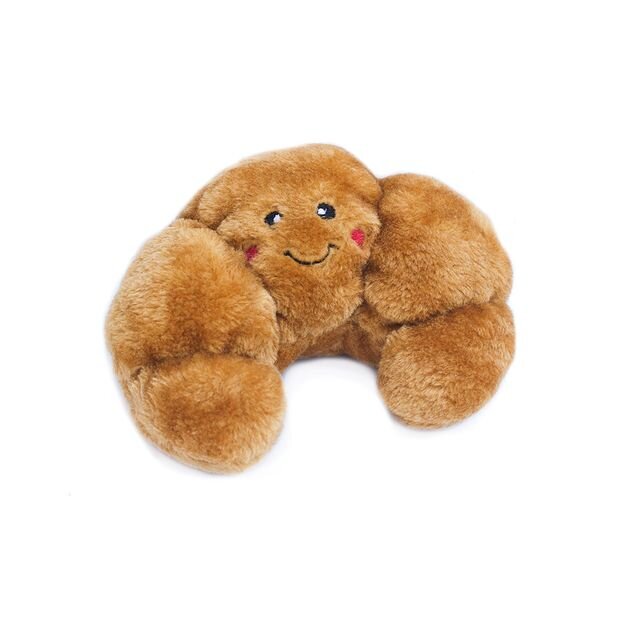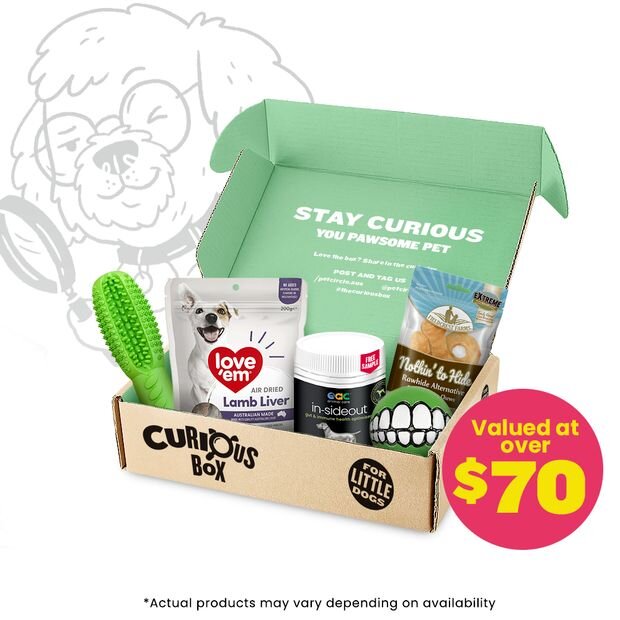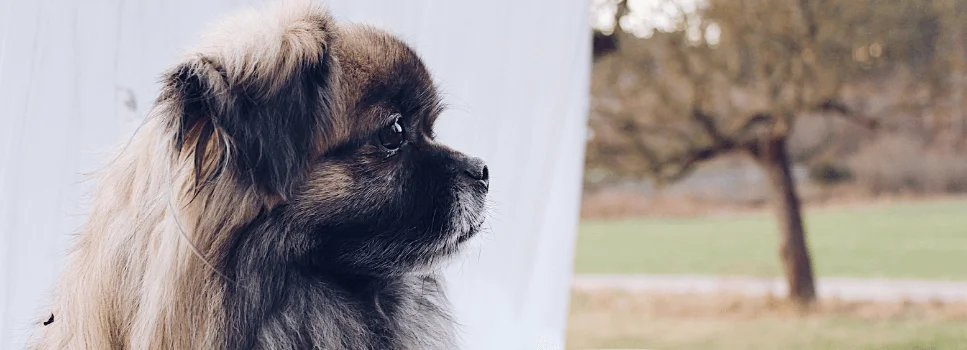Last Updated: 07/05/2025
Tibetan Spaniel | Breed Guide
Want to know more about Tibetan Spaniels? Check out our Vet-written guide for all the breed facts health diet and care tips.
Author: Dr Maree Monaghan BVSc (Hons)
Reading Time: 37 minutes - long read
A complete breed guide for Tibetan Spaniel Dogs
Despite their name, Tibetan Spaniels weren't developed as gun dogs like most spaniels but were bred by Buddhist monks in Tibet to provide companionship and act as watch dogs for their monasteries. The Tibetan Spaniel, affectionately known as "Tibbie" is a wonderful family pet that loves their family unconditionally and is an excellent watchdog.
Contents:
2. History
3. Personality
4. Best Toys and Accessories for Tibetan Spaniels
Tibetan Spaniel Facts
| Breed size: | Place of origin: | Intelligence: |
| Small | Tibet | High |
| Breed group: | Energy level: | Weight range: |
| Toy group | Moderate | 4.1 to 6.8kg |
| Life expectancy: | Tendency to bark: | Height range: |
| 12 to 15 years | Moderate | 25cm |
| Drool factor: | Ease of training: | Coat type: |
| Low | Moderate | Medium, silky double coat |
| Shedding factor: | Overall grooming needs: | Colours: |
| Moderate | Moderate | Any colour or mixture of colours, except merle |
How big do Tibetan Spaniels get?Tibbies are small dogs weighing between 4 and 7kg and standing 25cm at the shoulder. |
How much does a Tibetan Spaniels cost?Tibbie pups in Australia may cost anywhere from $1500 to $4000. The pandemic significantly increased demand for Tibbie puppies and the price of a purebred pup can occasionally even exceed this. |
Do Tibetan Spaniels shed?Tibbies are considered to be moderate shedders and will shed small amounts all year round with one or two big moults at any time of year. Shedding fur can be controlled with regular brushing (once a day might be needed during moulting) with a general plastic bristle brush or comb. Special attention needs to be paid to the long silky hair on their ears and legs as this tends to matt. Tibbies often need to have the hair on the bottoms of their paws trimmed if it gets too long. |
Are Tibetan Spaniels good pets?Tibbies are wonderful companions and are content to live in any type of home as long as they are not left alone for long. They are good with children and other pets and are just as happy lying around the house as they are going for a long walk or jog with their owner. |
How much exercise do Tibetan Spaniels need?Tibbies are an active dog, however, they will be just as satisfied with playing with toys in an apartment, running around your backyard or a long walk as long as they have the company of a human. |
How long do Tibetan Spaniels live?Tibbies are a generally healthy breed and can live for up to 15 years. As with any breed, Tibbies are much more likely to reach a grand old age if you don't let them become overweight and keep their teeth in top condition! |
How do I choose a Tibetan Spaniel breeder?When looking for a Tibetan Spaniel, your options are to: a) adopt from a rescue (this is our top recommendation!) b) buy from an or online marketplace or pet store (NOT recommended!), or c) Research a reputable breeder. Never purchase a puppy without inspecting the breeder's premises and asking the 10 Breeder Checklist Questions first. Good breeders socialise their animals, house them humanely, allow you to inspect their premises, and select for healthy traits and good temperaments. Read our Guide to Finding a Good Breeder for more tips. |
Do Tibetan Spaniels bark much?Despite their heritage as watchdogs,Tibbies are not prone to excessive barking. They do have a tendency to develop separation anxiety which can lead to a plethora of behavioural problems including excessive barking. As with any dog, they can be trained not to bark incessantly with positive reinforcement training. |
Tibetan Spaniel History

The lion is a revered animal in the Buddhist religion and Tibetan monks developed "little lion dogs" like the Tibetan Spaniel, Shih Tzu and Lhasa Apso to act as sentinels and companions in their monasteries. Tibetan Spaniels would lie on the walls and windowsills of the monasteries, keeping a watchful eye out for approaching dangers like bears, wolves and snow leopards. To ensure the safety of those in the monastery, Tibbies would alert their much larger companions, Tibetan Mastiffs, who are more than capable of dealing with any threat. Tibbies were also highly prized as companion dogs for the monks and were often given as gifts to visiting ambassadors, missionaries and nobles. This is how they made their way to the courts of Japan and China and eventually to Britain. The modern Tibetan Spaniel may share its ancestry with the Japanese Chin and the Pekingese.
Tibetan Spaniel Personality

Tibbies thrive on human companionship and are affectionate and devoted to their family. Although somewhat aloof with strangers, Tibbies are never aggressive and get along with children and other pets. Tibbies are intelligent, independent dogs that can be stubborn so they respond best to positive reinforcement when being trained. Renowned for their cat-like preference for perching in high places like window sills and the back of the lounge, Tibbies also love to snuggle with you in bed or on a pile of clean laundry!
Tibetan Spaniels make excellent apartment dogs as they don't need a lot of exercise, however, they are more than happy to go for a long walk with their beloved human. Due to their short faces and increased risk of heatstroke, it is preferable to walk your Tibbie in the cooler hours of the day or at night. Tibbies are smart and eager to please and can excel in activities such as obedience and agility.

Best Toys and Accessories for Tibetan Spaniels
A highly intelligent breed, Tibbies thrive on mental stimulation and benefit from problem solving toys. Plush toys are perfect for Tibbies to carry around and to cuddle for comfort when they are alone.
Puzzle feeders provide stimulation for your clever Tibbie's brain and decrease their chances of developing separation anxiety
The KONG Wubba is perfect for Tibbies to play with by themselves or with their beloved humans

Combining the fun of a squeaky toy and plush comforting snuggle buddy, this toy will be your Tibbie's new non human best friend.
The Toppl is a sturdy, durable and squishy treat-dispensing dog toy that's not only gentle on teeth, but also entertaining and you can up the difficulty level by connecting a large Topple with a small Toppl for extra fun!
Can't decide? Why not let us choose for you with Curious Box? Each Curious Box contains a selection of the most popular and top-rated products on the market, so you can be sure this box will please even the most fussy pets! Even better, the theme changes every 6 weeks, making it the perfect way to keep your dog's supply of toys and treats fresh, fun, and varied!

Tibetan Spaniel Diet and Nutrition

Tibetan Spaniel Puppies
Some points to note about Tibetan Spaniel puppy ownership include:

Food:Tibbie puppies should eat a premium, small breed formula such as Royal Canin Mini Puppy, Hills Science Diet Small Puppy or Advance Small Puppy until they are 10 months of age.

Behaviour:Tibetan Spaniel puppies have fantastic personalities but do like to chew and destroy things, just like any puppy! Puppy proofing your house is essential. Remove any easy-to-reach toxins or electrical cords, and provide plenty of toys!. For more information on puppy behaviour, take a look at our Puppy Training Guide

Worming:Tibbie puppies need to be wormed fortnightly from the age of 2-12 weeks, and then once per month after this. In Australia, Tibetan Spaniel puppies also require heartworm protection. You may wish to get a heartworm injection yearly at your vet, or you can simply give a monthly treatment such as Nexgard Spectra, Simparica Trio or Credelio Plus.
For more helpful information on worming, training, socialisation, and nutrition, consult our veterinary-written Complete New Puppy Guide: New Puppy Guide
What To Feed A Tibetan Spaniel Puppy:
Tibbie puppies need to eat a premium small breed diet that is nutritionally formulated to meet AAFCO Guidelines until they are 10 months of age. You may consider a Rotation Diet to provide exposure to different proteins and reduce the risk of food sensitivities.
Raw diets for Tibetan Spaniels? Raw diets are not suitable or safe for Tibbie puppies due to the risk of bacterial contamination, which can lead to food poisoning and upset their sensitive tummies. Plus, an unbalanced diet can lead to nutritional deficiencies. Read more about Raw Diets: The Risks and Benefits.
When should you transition a Tibetan Spaniel from puppy to adult food? As a general guide, Tibbies can usually be transitioned from a 'puppy' food to an 'adult' food at around 10 months of age. This does, however, vary depending on your pup's body condition score - if your pup is underweight, they may require puppy food for a little longer. Likewise, if they're starting to show a bit of 'pudge', it may be time for a lower-in-calories 'Adult' diet.
To find out how whether your pup is ready to transition to an adult diet, take a look at our Body Condition Assessment Charts, or ask our Vet Squad for further advice.
Our top recommendations for Tibetan Spaniel puppy food include
This premium puppy dry food contains nutrients to bind salivary calcium to help reduce dental tartar build up and support your Tibbie puppy's dental health.
Australian made premium puppy wet food with high levels of omega 3 fatty acids, zinc and linoleic acid to keep your Tibbie puppy's coat healthy and luxurious.
Made with natural ingredients and contains special small breed antioxidant blend for lifelong immune support for your Tibbie pup.
This highly palatable hypoallergenic grain free puppy dry food contains salmon and fish as its first ingredients, with a smaller kibble size perfect for puppy mouths.
Best Food for Adult Tibetan Spaniels
Tibetan Spaniel adults are prone to joint and dental disease and so the following diets have been recommended to help support healthy joints and teeth.
This specially formulated dry food contains glucosamine and chondroitin, the building blocks of healthy joints and cartilage to slow down wear and tear in your Tibbie's joints.
This specially formulated dry food contains glucosamine and chondroitin, the building blocks of healthy joints and cartilage to slow down wear and tear in your Tibbie's joints.
An all meat, grain free, raw, freeze-dried diet Omega fatty acids to maintain your Tibetan Spaniels's joint function and skin and coat health.
This premium quality food has a scientifically designed kibble shape, size and texture which helps to reduce the formation of dental tartar by polishing the surface of your Tibbie's teeth with each chew.
For more information, check out our article on What is the Best Food for Small Dogs?.
Tibetan Spaniel Health Problems
Although a generally healthy breed, Tibetan Spaniels can suffer from inherited diseases as well as joint and dental problems.
1. Patellar Luxation
Patellar luxation refers to a condition where the dog's kneecap slips out of its normal position. It is often associated with skeletal deformities that are present at birth. Frequent dislocation of the kneecap can cause locking of the leg and pain in the joint. Dog owners will often notice their dog skip or run around on three legs, holding up the leg with the problematic patella. Luxation occurs when there is a structural abnormality or when a traumatic injury has affected the joint. Keeping your dog at a healthy weight and avoiding rough exercise can help ease the pressure on the joint and reduce symptoms.
2. Brachycephalic Airway Syndrome
Tibetan Spaniels are a moderately Brachycephalic ('flat faced') breed, which can lead to obstructive airway syndrome in certain individuals. Affected animals can vary in severity from noisy or laboured breathing and snoring, to complete collapse of the airway. This condition is worsened by obesity, heat and exercise, therefore extreme caution is advised when exercising and playing in the heat.
3. Progressive Retinal Atrophy
Progressive Retinal Atrophy (PRA) is a common inherited eye disease in many breeds of dogs that causes gradual vision loss leading to blindness. The gene for this disease in Tibbies has been identified and can be tested for in dogs that are being considered for breeding.
4. Hip Dysplasia
Hip dysplasia refers to a condition where the conformation (physical structure) of the hip joint is abnormal. A healthy hip joint operates as a smooth 'ball and socket' type joint, whereas hips affected by dysplasia typically have a flattening of the 'socket' component of the joint, resulting in a shallow joint where the 'ball' or head of the femur is not held securely. This leads to instability of the joint which may cause pain in the young dog (juvenile hip dysplasia) and ultimately causes development of osteoarthritis.
Best supplements/products for Tibetan Spaniels:
Due to their propensity to develop conditions of the joints, many Tibetan Spaniel owners are advised to provide joint care preventatively. Suitable joint care methods for Tibbies may include joint care supplements, a joint care diet, or even simple things like ensuring your dog maintains a healthy weight.
A premium quality, vet recommended joint supplement containing green lipped mussel and epitalis to help support joint health and ease the symptoms of arthritis.
These chews contain glucosamine and chondroitin which are naturally found in joint fluid and cartilage.
A safe, natural treatment that may help to alleviate the signs of arthritis and improve healthy mobility and can also be used in young animals following injury or surgery.
Related Breeds
Pekingese
The Pekingese graced the palaces of Chinese nobility for centuries as treasured companion dogs and used to be small enough to fit in the capacious sleeves of their owners' robes. True to their royal background, these little "lion dogs" can be aloof and opinionated, however, they are loyal and faithful companions and form tight bonds with their favourite humans.
Lhasa Apso
The Lhasa Apso were also in Tibet as guard dogs for Buddhist monasteries. Despite their small size and deceptive long flowing locks, the Lhasa Apso is still a fiercely independent guard dog.
Japanese Chin
The Japanese Chin is an ancient toy breed that may have evolved from the Tibetan Spaniel although their actual origins are shrouded in mystery. These charming intelligent little lap dogs are also known for being cat-like and like to rest in high places.
Further Reading
Want to know more? Check out our Discover Page for more tips from our expert vets on keeping your pets happy and healthy.